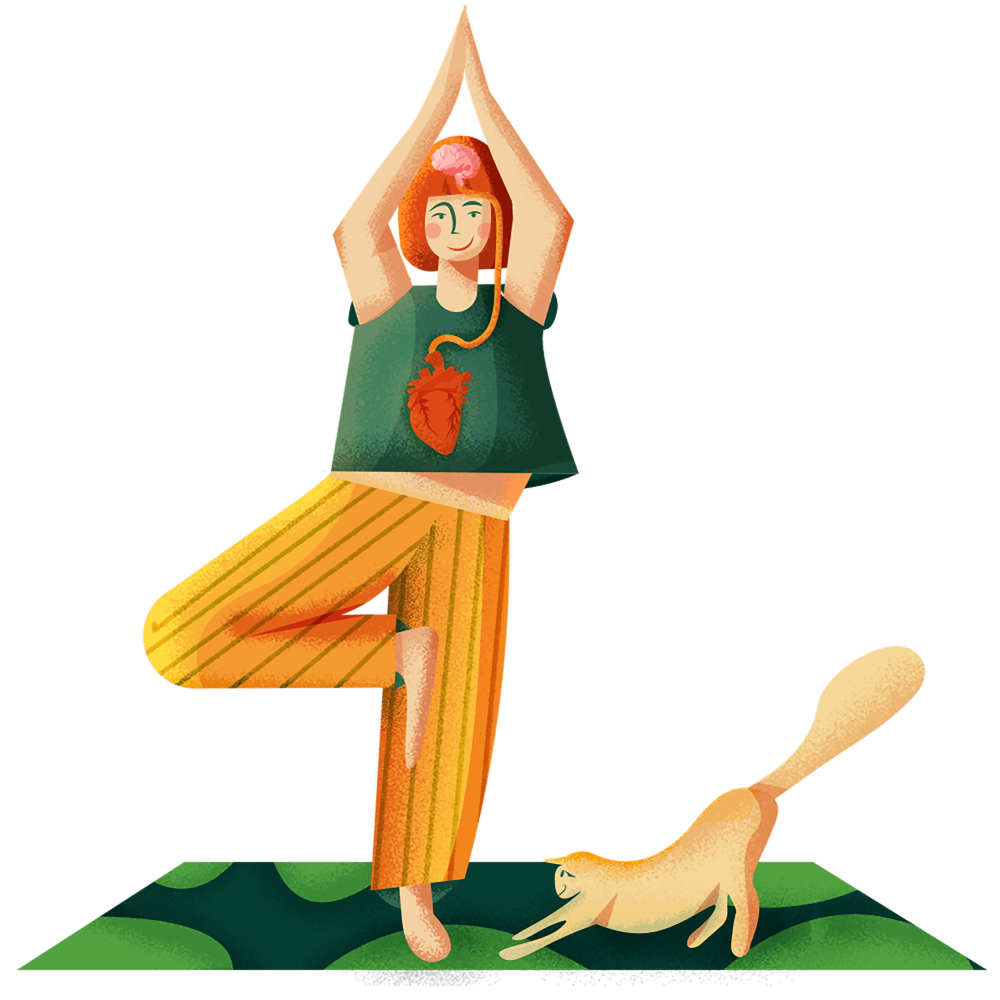Authentic trauma healing involves more than the mind
Illustrations by Mahnoor Khan
In my journey to heal childhood trauma, I’ve followed social media content creators who appear to have the “answer” about the best way to release trauma from the body. Across various platforms, there are many who claim to have the key to this piece of healing. But how do you know if what they’re offering is valid?
For years, Cognitive Behavioral Therapy (CBT) has been the standard for treating conditions associated with trauma, which include sleep disturbances, irritability, mood swings, anxiety, depression, and persistent fatigue, according to the US Substance Abuse and Mental Health Services Administration. Commonly known as talk therapy, many therapists have discovered that CBT alone isn’t enough.
“When it comes to unresolved trauma, there are some other components at the table that are not conscious,” said Logan Cohen, a licensed marriage and family therapist. “There's a central nervous system dysregulation happening constantly.”
The body’s nervous system automatically controls things like breathing and heartbeat, but to maintain rest and digest functions critical to good health, it’s up to us to keep it regulated. When our bodies are stuck in the fight/flight/freeze/fawn loop of unresolved trauma, it’s an indication that we don’t feel safe, which dysregulates our nervous systems.
by Mahnoor Khan
Dr. Stephen Porges, a psychiatrist and scientist who has written extensively on the subject, said cues of safety are essential for nervous system regulation. “When a nervous system is primed to be defensive, it interferes with recruiting circuits of health, growth, and restoration,” he noted. “Our evolutionary heritage is this need to connect and feel safe with others.”
One of the ways mental health professionals have found to facilitate total healing is through somatic experiencing, a body-centered approach to addressing the conditions associated with unresolved trauma. It has been shown to increase feelings of safety in the body, which naturally regulates the nervous system.
An analysis of somatic experiencing studies conducted by Maria Kuhfuß, et al in 2021 offers preliminary evidence that this modality has positive effects on symptoms associated with Post Traumatic Stress Disorder, a common diagnosis for those with unresolved trauma. While more research is needed to prove the benefits, anecdotal evidence supports the value.
Before experimenting with any of these practices, however, Cohen says it’s important to determine which of the survival stages you’re in. If you’re in fight or flight, you need to downregulate, or calm your nervous system, he advises. One technique he recommends is breathwork.
“The types I like to recommend are 4-7-8 breathing and the physiological sigh,” he says. “Some other ways to downregulate include talking with someone you love about what's going on, petting a dog or cat, stretching to get back into your body and release the unconscious muscle bracing, and progressive muscle relaxation.”
Clinical psychologist Joi K. Madison endorsed similar techniques, along with body scanning and progressive muscle relaxation because it’s important to keep “the focus on increasing awareness and maybe even tolerance for certain bodily sensations and eventually working towards interpreting what these sensations mean” in order to extract the wisdom of our bodies.
by Mahnoor Khan
Those stuck in freeze mode need to upregulate, or activate, their nervous systems. To do that, Cohen recommends techniques like placing your forearms in an ice bath or slowly turning down the temperature of the shower. “This prompts a dopamine response, which is the pleasure hormone,” he said. Cohen cautions there’s no need to start with extremes like cold plunges. “Even small steps will prompt these chemical reactions,” he noted.
Another popular technique is EFT Tapping, a modality that includes using verbal statements in combination with tapping on specific acupressure points to reduce symptoms related to unresolved trauma. According to a study published in the Journal of Evidence Based Integrative Medicine in 2019, this method has been proven effective to reduce both anxiety and depression.
Content on social media around healing trauma in the body includes recommendations like lying on your stomach and rolling your hips back and forth or slamming a pillow on the ground repeatedly, along with warnings that if you hear clicking or popping in your joints, have unexplained chest pains or are fatigued it means you have stored trauma. But is this true?
The best way to know if you’re getting accurate information is to do your homework. “Cross-reference any information you’re considering applying with a credible source,” suggested Madison. Some of those include “sites and blogs run by licensed professionals such as Psychology Today and Therapy for Black Girls. Where your health is concerned, be diligent about getting accurate and up-to-date information from informed sources.”
It’s important to remember that every body is different. While some benefit from breathwork, others may find themselves triggered into fight or flight because the level of calm created by the exercises is so unfamiliar. Don’t force yourself into trying something just because you saw it on social media and want relief from emotions that are uncomfortable. The best advice is always to seek out professional help from someone who is trained and educated.
Here are some resources for your journey:
Irene Lyon– certified Somatic Experiencing® practitioner with dozens of free resources
Our Polyvagal World – book by Dr. Stephen Porges, et al that takes the science of the nervous system and translates it into lay terms
The Body Keeps the Score – book by Dr. Besser van der Kolk about how trauma stays in the body
Healing Trauma Through Somatics – free one-day summit on July 20, 2025
Ergo Institute – founded by Dr. Peter Levine, creator of the Somatic Experiencing® method.
After years of caregiving, complex trauma, and undiagnosed neurodivergence, Staci B’s nervous system was stuck in survival mode. Refusing to stay there, she became a Nervous System Regulation Crusader, translating complex science into accessible tools and stories. Now a journalist, author, and speaker, she shares her journey in The Nervous System: Before and After to help others reclaim their lives.
your contribution is tax-deductible
KEEP EXPLORING:




